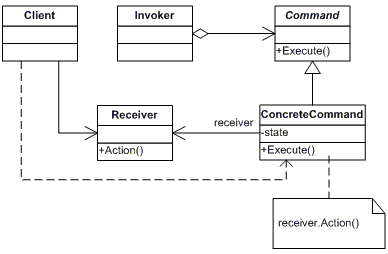Encapsulate a request as an object, thereby letting you parameterize clients with different requests, queue or log requests, and support undoable operations.
Participants
- Command: declares an interface for executing an operation
- ConcreteCommand: defines a binding between a Receiver object and an action. Implements Execute by invoking the corresponding operation(s) on Receiver
- Client: creates a ConcreteCommand object and sets its receiver
- Invoker: asks the command to carry out the request
- Receiver: knows how to perform the operations associated with carrying out the request.
Code
public class Main {
public static void main(String[] args) {
Receiver receiver = new Receiver();
Command command = new ConcreteCommand(receiver);
Invoker invoker = new Invoker();
invoker.setCommand(command);
invoker.executeCommand();
}
}
public abstract class Command {
protected Receiver receiver;
public Command(Receiver receiver) {
this.receiver = receiver;
}
public abstract void execute();
}
public class ConcreteCommand extends Command {
public ConcreteCommand(Receiver receiver) {
super(receiver);
}
@Override
public void execute() {
receiver.action();
}
}
public class Receiver {
public void action() {
System.out.println("Called Receiver.action()");
}
}
public class Invoker {
private Command command;
public void setCommand(Command command) {
this.command = command;
}
public void executeCommand() {
command.execute();
}
}
Output
Called Receiver.action()









Top comments (0)